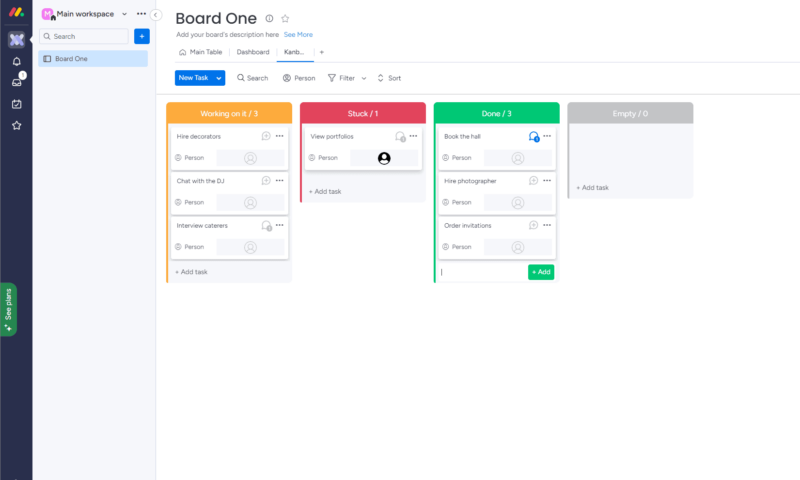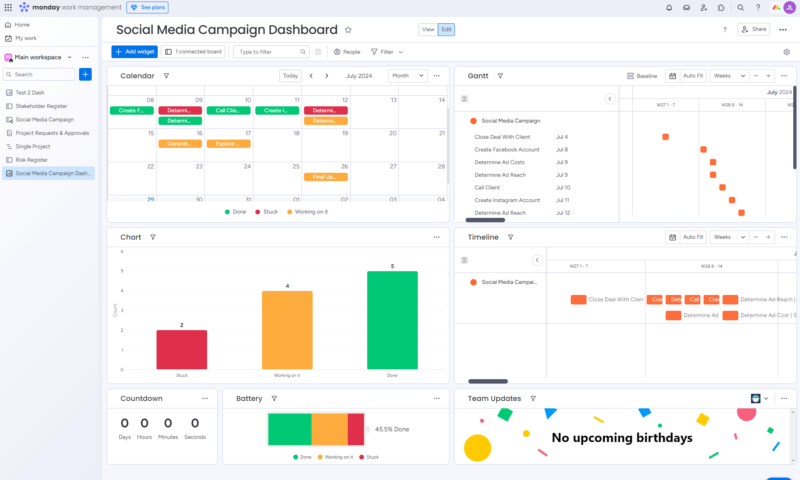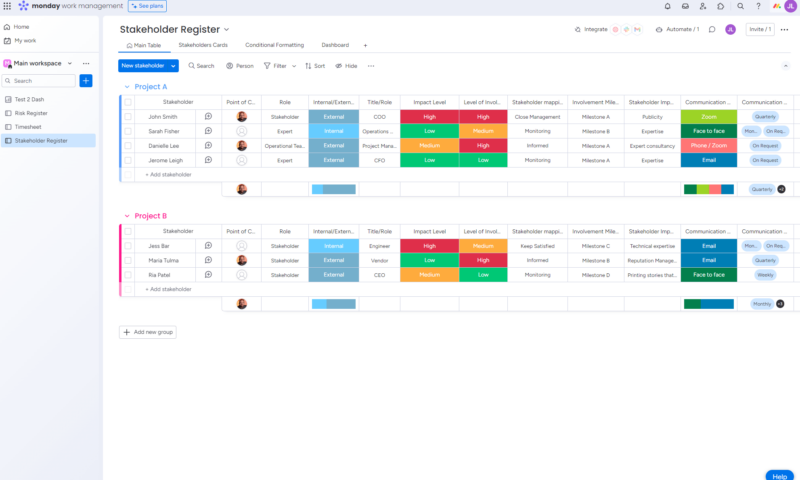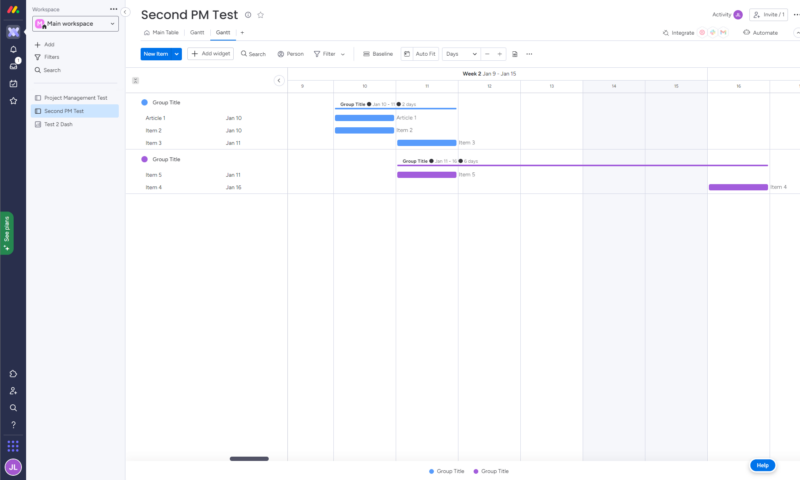What Is monday.com?
monday.com is an all-in-one project management platform that’s designed to be used with traditional and Agile project management methodologies. It provides workflow management tools like kanban boards, Gantt charts and calendars; offers time, resource and financial management tools; and can be used as a customer relations management (CRM) platform.

monday.com offers kanban boards (pictured), Gantt
charts and more tools for managing tasks.
The software is affordable and easy to use via dedicated desktop, mobile and browser versions. You can learn more about monday.com’s tools and plans in our full monday.com review. If monday.com doesn’t sound like your cup of tea, read our project management comparison guides to see if another platform sounds better.
Check out our ClickUp vs monday.com guide to learn about powerful team collaboration tools like real-time document editors, whiteboards and mind maps. Alternatively, if you use only the Scrum framework, spend some time with our monday.com vs Jira guide.
What Is the monday.com Work OS?
“monday Work OS” (work operating system) is the name the monday.com team has given the software. Essentially, monday.com is a one-stop shop for project management, CRM, document management and more.

monday.com’s selection of templates, including one for CRM,
makes it a solid work OS for multiple industries.
Whether you work in software development, marketing, HR or support roles, you’ll find the tools you need. The platform is ideal for organizations big and small, including startups and established businesses. Below are some of the features you’ll find on monday.com.
- Workflow tools: Work teams will find easy-to-use kanban boards and Gantt charts, calendars and boards that make tracking project tasks a piece of cake. Check out our guide on how to use the monday.com calendar to learn more about this tool.
- Time management: In addition to tracking tasks, users can use the work OS to track time. The time tracking tools, which help project managers understand how time is being spent, are straightforward and are part of the reason why monday.com tops our roundup of the best time management tools.
- Resource management tools: Whether you’re resource leveling or resource smoothing, monday.com’s boards will help you out. Check out our guide on how to use monday.com boards to learn how to become a board ninja.
- Integrations and automation: Integrations and automations help expand the platform’s capabilities. You can quickly import data from other business software and automate processes and workflows. Read our guide on how to create monday.com recurring tasks to learn how to implement automations.
- Templates: monday.com’s templates can help managers get a project off the ground in minutes. You can find templates for HR, healthcare, construction, software development and more. You can even find templates for RACI charts and other business strategies. Learn more in our roundup of the best monday.com templates.
- Project dashboards: One of the most efficient ways to track key project metrics is via dashboards. The dashboards on monday.com are customizable and can be shared with stakeholders and clients. To learn more about this tool, read our guide on how to use monday.com dashboards.

Dashboards on monday.com are customizable and
allow you to quickly see key project metrics.
Now that you know what monday.com is and how this work OS can help teams across multiple industries and organizations, it’s time to look at three monday.com case studies to understand how other companies have successfully used the platform.
1. Howard Kennedy

monday.com has the tools and flexibility law firms need.
The Howard Kennedy law firm, based in the United Kingdom, was no stranger to monday.com before it embarked on a journey to grow its business. The firm used the platform to help manage its Agile-based portfolio. What they didn’t know is that they could use monday.com to help them grow their business and keep everyone on the same page.

Boards on monday.com allow teams to see and manage tasks,
leave comments and enter critical task information.
By harnessing monday.com’s tools, the executive team was able to align daily and weekly business tasks with the firm’s long-term business strategy. Additionally, the team improved collaboration across departments from HR to finance to IT by keeping everyone better informed via boards and dashboards that showed tasks, objectives and critical performance data.
Future Prospects
Howard Kennedy’s future prospects appear to be good. Tony McKenna indicated that the firm was once slow to adopt digital tools to help manage business operations and instead relied only on technology to help it serve clients and manage cases.
Now, the firm uses workflow management tools, automations and integrations to manage the business, legislative timelines and billing. The team also uses monday.com to view actual costs versus estimates and receive alerts. The use of monday.com has helped ensure team members can focus on tasks relating to operations and business strategy across multiple departments.
2. Wix

monday.com helped Wix grow rapidly.
Wix, once a small startup that launched a platform for aspiring website owners and designers, experienced rapid growth. Within two years, the small company grew from less than 50 employees to more than 1,000 and exploded into a company worth $1 billion, with offices in 16 cities across six countries. 2

A RACI chart can show which team members are accountable for specific tasks.
The company knew it had to do something to help manage employees and tasks and still provide a service to its 73 million users. 2 Using workflow management tools, Wix leaders devised a workflow that allowed all team members to see what everyone else was working on across multiple departments and who was in charge of specific jobs.
Future Prospects
Wix CEO and co-founder Avishai Abrahami says that thanks to monday.com, he knows everything that’s happening at Wix. Though the processes are not as simple as they were when the team was small, monday.com helps him get caught up as if he were sitting across a table having lunch with individuals and teams.
Eliminating the need for numerous meetings, emails and phone calls freed the CEO (and others, we’re sure) to better understand what everyone was working on by asking about their ideas, visions and plans. Wix’s future prospects appear bright thanks to its willingness to embrace software to help save time and focus on the bigger picture.
3. Officeworks

Officeworks has successfully used monday.com
to improve workplace efficiency.
According to Micro Space Planning Manager James Fryer, before Officeworks started using monday.com, its processes were “clunky” — not ideal for a company that adds thousands of new products yearly. In addition, its communication was classed as “scattered ad hoc,” which is not great for a company with 165 stores and 40,000 online product SKUs. 3

Officeworks uses Gantt charts to help plot important timelines.
Instead of using a work OS like monday.com, Officeworks relied on multiple folders and spreadsheets with more than 100 tabs, all manually updated with data that different teams delivered by various means. After the company embraced monday.com, the situation improved. The platform’s intuitive tools and customization options were easy for the whole team to use.
The company needed to visualize workloads, identify resource gaps, manage documents and track tasks. After designing a workflow, the company could balance workloads, use templates for consistency, utilize dashboards and boards, and automate tasks. The team could also connect and collaborate on planograms for stores and plot timelines using Gantt charts.
Future Prospects
Officeworks has a promising future. The company can now easily replicate store opening processes, collaborate more efficiently and generate consistent data. It has also seen an improvement in direct costs, time savings and staff workloads. According to James, “It’s a win all around.” 3
